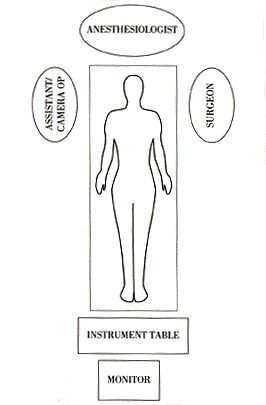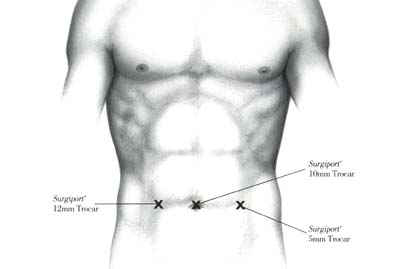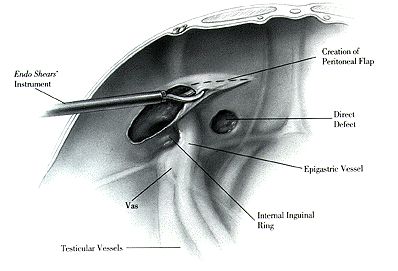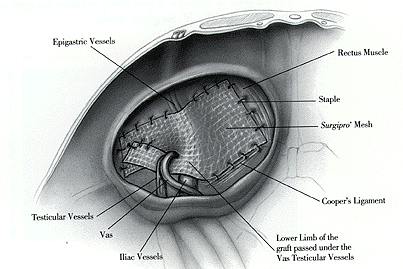|
| This technique was used by our surgical team from 1990 until mid 1996 . It was not discontinued because of poor results, rather our technique matured and mandated the introduction of newer instruments and technical variations. However, this technique remains the basis for the TAPP repair. |
| Hardware Required |
|
- 1) Storz Zero Degree 10 mm Telescope,
- 2) Storz Camera (three chips or single chip),
- 3) Storz High Insufflator,
- 4) CO2 Tank,
- 5) High Resolution Sony Monitor 21 inches,
- 6) Optional Printer - Storz
| Anesthesia |
|
General Endotracheal Anesthesia is used. Each patient is injected in the Pre-induction phase with 60mg IM Toradol (Roches Pharmaceuticals) and with 2grs. of Cefizox IV (Fujisawa Laboratories)
| operating room set-up |
|
The patient is in supine position, arms tucked at the side. The surgeon stands at the head of the table opposite the hernia. No dedicated surgical assistant is used for these procedures. A scrub nurse/camera holder will sit at the head of the operating table across from the surgeon.

| Instruments |
|
| The Technique (Original TAPP - Pre 1996) |
|
A pneumoperitoneum is created using a Verres Needle. An intra-abdominal pressure of 15 mm Hg is maintained.

The 10 mm trocar is inserted in infra-umbilical position. The telescope is then inserted and the intra-abdominal cavity explored. If bilateral inguinal hernias are present, two12 mm trocars are inserted on the lateral border of each Rectus Muscle. For unilateral repairs, a 5 mm trocar is placed on the ipsi-lateral side of the hernia and a 12 mm on the contra-lateral side.

| STEP 1: Creating the Peritoneal Flap |
|
The repair is initiated. The laparoscope is pointed toward the afflicted inguinal canal. The peritoneal defect or hernia is identified. The other inguinal canal is inspected. If an asymptomatic hernia sac is found on the other side, our protocol mandates its repair, even though at this time we are unsure of its exact clinical significance. The Lateral Umbilical Ligament is located as well as the Inferior Epigastric Artery and Vein. A peritoneal incision is made using the EndoShear* Instrument connected to an electrocautery source. The incision is extended from the lateral aspect of the inguinal region to the Lateral Umbilical Ligament. For obese patients, this ligament may have to be transected in order to obtain additional exposure. The operator should be meticulous in making this incision as high as possible to maximize the exposure of the region.
| STEP 2: Exposing the Inguinal Structures |
|
Using the Endodissect* Instrument bluntly, Cooper's Ligament is exposed as well as the Inferior Epigastric Vessels and the Spermatic Cord. It is essential to expose the uncovered abdominal wall meticulously (without peritoneum) and remove all fatty layers.
| STEP 3: Dissecting the Hernia Sac |
|
The indirect inguinal hernia sac should be dissected carefully from the Spermatic Cord. Particular care should be taken not to dissect lateral and inferior to Cooper's ligament, as the Iliac Artery and Vein will enter the femoral canal at this site.

| STEP 4: Inserting and Anchoring the Mesh |
|
The SurgiPro* Mesh is now inserted into the intra-abdominal cavity via the 10 mm trocar. The Mesh is rolled and pushed through the 10 mm trocar with a grasper, then packed in the most medial aspect of the inguinal region above Cooper's ligament and deployed over the inguinal region using two "Grasper-type" Instruments. There are three methods to place and secure the mesh over the inguinal region. The clinical outcome is identical for all three methods.
- On-Lay Mesh Placement: The Mesh is inserted uncut and into the intra-abdominal cavity and deployed over the inguinal region. It is stapled first to Cooper's Ligament, then on top of Hesselbach's triangle, over and lateral to the Inferior Epigastric vessels.
- Mesh Wrapped Around the Spermatic Cord: A spermatic window is created behind the Spermatic Cord at the junction of the Inferior Epigastric Vessels and the Spermatic Cord. The window should be 1 to 2 cm in size. The cut Mesh is inserted . Two limbs have been formed: a 2" limb and a 1" limb. The Mesh is laid over the inguinal region, and the small limb passed through the spermatic window and wrapped around the spermatic cord.
- Double Mesh: In some patients, namely patients with large indirect inguinal hernias, a double graft is inserted to securely cover the entire, large inguinal ring. A first graft is wrapped around the spermatic cord and a second graft is placed on top of the first one, in a slightly more lateral position.

The Mesh is then secured with the EndoHernia* stapler. It is first stapled on Cooper's ligament with smaller staples (Blue or 4.0 Endostaples). Next we place several staples perpendicular to the ligament followed by a row more lateral and parallel to Cooper's Ligament. The Posterior Rectus Sheath Aponevrosis area is stapled. The graft is also anchored around the Inferior Epigastric vessels and lateral to them. If the graft is wrapped around the spermatic cord, both limbs are stapled closed. No staples are placed lateral and inferior to Cooper's Ligament, as this is entry site of the Iliac Vessels into the Femoral Canal.
| STEP 5: Closing the Peritoneum |
|
The peritoneum is closed using Endostaples*. Homeostasis is checked. The lateral trocars are removed and the trocar sites obliterated with a finger while the operator checks for bleeding or potential injuries to the Inferior Epigastric Artery . The lateral 12 mm trocar site is closed in the usual fashion after the abdomen is deflated. The intra-abdominal cavity is then insufflated again and the telescope reinserted to verify the absence of injuries while closing the 12 mm trocar site.
The last trocar is removed, and the insertion sites are closed in the usual fashion.